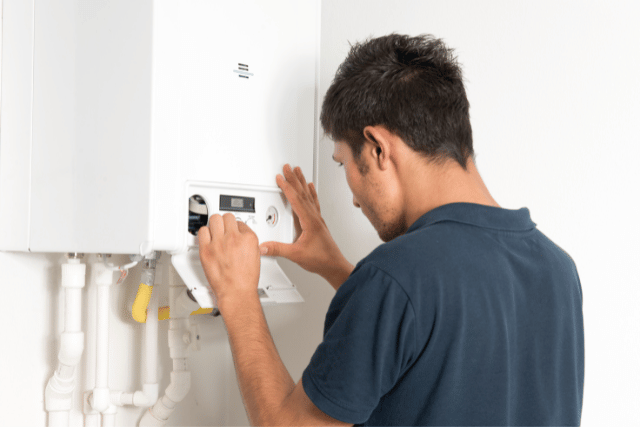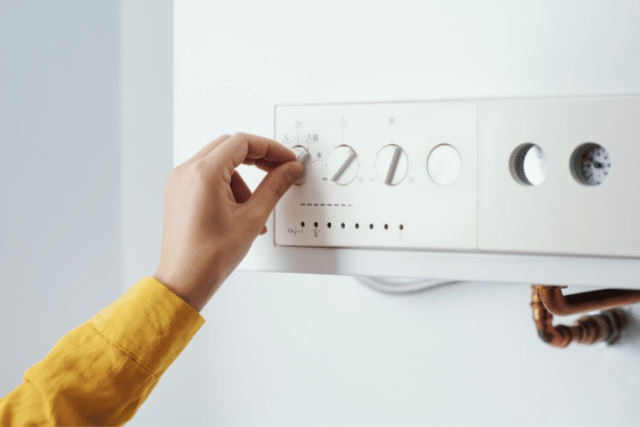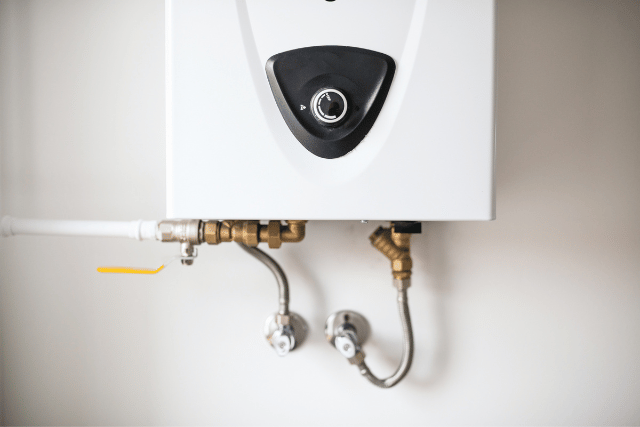What Is A Condensing Boiler?
A condensing boiler is a type of central heating system that uses condensing technology to maximize energy efficiency. Unlike traditional non-condensing boilers, they are designed to capture and use the latent heat from the water vapor produced during combustion.
The condensing process allows the boiler to get more heat from the fuel, increasing the overall efficiency of the boiler. Because of this, they have an efficiency rating of over 90%, in comparison to non-condensing boilers which have far lower efficiency ratings between 70% and 80%.
This higher efficiency rating results in lower energy consumption and reduced fuel costs.
Condensing boilers have become the standard choice for new installations and boiler replacements in many countries due to their energy efficiency and environmental benefits. Their high efficiency and environmental benefits have made condensing boilers popular across Europe and throughout the UK, where government grants under the ECO4 scheme help people to install condensing boilers in their homes.
Find out if you are eligible for a free boiler grant today by filling out our contact form!

How Does A Condensing Boiler Work?
A condensing boiler works by using condensing technology to extract and utilise the latent heat from the water vapor produced during combustion.
Here is how a condensing boiler works:
Combustion: The boiler burns fuel, such as gas or oil, in a combustion chamber. This process generates heat and produces hot gases, including water vapor as a by-product.
Primary Heat Exchange: The hot gases and water vapor pass through a primary heat exchanger. The primary heat exchanger is a metal component that allows heat transfer from the hot gases to the circulating water within the system. The water absorbs heat from the gases and increases in temperature.
Condensation: The hot gases and water vapor then move to a secondary heat exchanger. The secondary heat exchanger is specifically designed to facilitate condensation. It is usually made of corrosion-resistant materials to handle the acidic nature of the condensate.
Latent Heat Recovery: As the water vapor meets the cooler surface of the secondary heat exchanger, it begins to condense, releasing latent heat. This latent heat is the energy contained in the water vapor that was not utilized in non-condensing boilers. The heat exchanger maximizes the transfer of this latent heat to the circulating water, further increasing its temperature.
Flue Gas Discharge: The cooled gases, now devoid of most of their heat and moisture, exit the boiler through a flue pipe. The condensed water vapor forms a liquid known as condensate, which is collected and drained away from the boiler through a condensate pipe.
Heating System Distribution: The hot water, now significantly heated through the combustion and condensation process, is circulated throughout the heating system. It can be used to provide central heating via radiators, underfloor heating, or to supply hot water for domestic use.
Is A Condensing Boiler The Same As A Combi Boiler?
No, a condensing boiler is not the same as a combi boiler. A combi boiler is a specific type of condensing boiler that combines heating and hot water functions in a single unit, whereas a condensing boiler refers to any boiler that incorporates condensing technology to help increase energy efficiency.

What's Condensing?
Condensing is the process of converting a substance from its gaseous state to a liquid state. In the context of boilers, condensing specifically refers to the condensation of water vapor produced during combustion.
When fuel is burned in a boiler, it produces hot combustion gases and water vapor as by-products. In a condensing boiler, the hot gases and water vapor pass through a secondary heat exchanger designed to help the process of condensation. As the water vapor comes into contact with the cooler surface of the heat exchanger, it cools down and changes from a gaseous state to a liquid state, causing it to release any stored heat.
The condensation of the water vapor in a condensing boiler is beneficial because it allows for the recovery and usage of the additional heat that would be wasted in other types of boilers.
What Is A Non-Condensing Boiler?
A non-condensing boiler is a type of central heating system that does not use condensing technologies.
This type of boiler is fuelled by gas or oil and work by heating water that is circulated through radiators or underfloor heating systems to provide warmth to a building. The heated water returns to the boiler for reheating, and the process continues. These boilers have a flue, which is an exhaust pipe that expels waste gases generated during combustion.
During combustion, gases and water vapor are produced, non-condensing boilers allow these waste gases and vapor to be released without being condensed into a liquid. A significant amount of heat is lost as water vapor is expelled from the boiler.
Non-condensing boilers were installed in the UK up until the early 2000s, up until condensing boilers started to become more popular and eventually, the standard for central heating systems.

How Does A Non-Condensing Boiler Work?
A non-condensing boiler works in a much simpler way when compared to a condensing boiler. Here is how a non-condensing boiler works:
Combustion: The boiler burns fuel in a combustion chamber. The fuel is ignited, producing a flame that generates heat.
Heat Exchange: The hot combustion gases produced during combustion flow through a heat exchanger. This transfers heat from the gas to the water circulating within the system. The water absorbs the heat and increases in temperature.
Flue Gas Discharge: After passing through the heat exchanger, the combustion gases, along with any water vapor produced during combustion, are released through the flue. The flue is an exhaust pipe that vents the waste gases outside the building.
Heating System Distribution: The heated water is circulated throughout the heating system through pipes, radiators, or underfloor heating systems. This provides warmth across the building.
Return of Cooled Water: The water that has circulated through the heating system and given off its heat returns to the boiler through a return pipe. The cooled water is then reheated in the boiler and recirculated again, completing the heating cycle.
In a non-condensing boiler, the water vapor produced during combustion is expelled along with the waste gases through the flue without condensing into liquid form. This means that the latent heat contained in the water vapor is not recovered or utilized. As a result, non-condensing boilers have lower energy efficiency compared to condensing boilers since they do not maximize the heat energy extracted from the fuel.
Condensing Vs Non-Condensing Boilers
Condensing vs non-condensing boilers – which one is better? To put it simply, condensing boilers are significantly more energy efficient. This is going to save you money on your annual energy bill, in some cases it has been as high as a saving of 30%.
Not only will a condensing boiler save money on your energy bills, but they are also a lot more environmentally friendly than non-condensing boilers. Their higher efficiency means they produce less waste and have a lower fuel consumption. This is going to help significantly reduce your carbon footprint.
they also provide a more consistent and precise way of heating a building. By changing their output based on the heating demand, the heat supply is adjusted to match the requirements of the building.
Apply For A Boiler Grant
Apply for a condensing boiler grant today by filling out our quick eligibility form below. Once you have filled out the form, a member of our team will be in touch with you to discuss the next steps.

